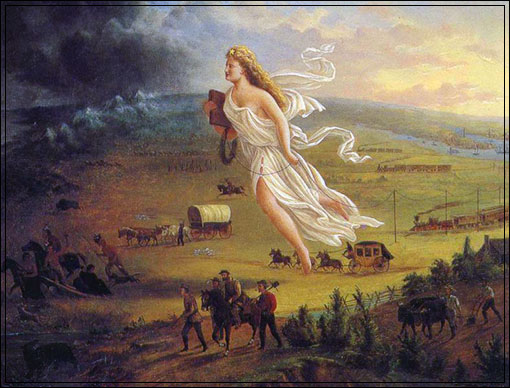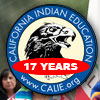 |
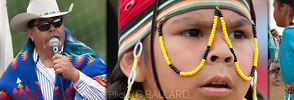 |
 |


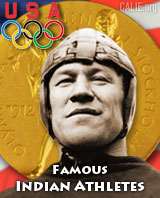
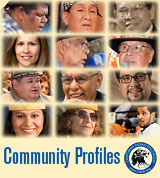
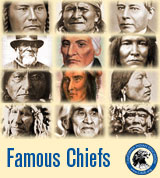
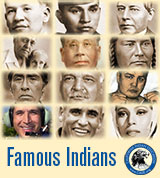

Publishing Corner: Indian Community: Science & Wonder Indian Heros: California Indian Art: CALIE Library: Academic Financial Aid: Tribal Governments: Indian Gaming: |
A STUDENT WORKS PUBLICATION — High School Thesis
Shane Larsen (Lakota Sioux), an 18-year old Trinity Classical Academy high school student, wrote this research paper on Manifest Destiny for his senior thesis project. Shane has plans to attend Northern Arizona University with a major in forestry, minor in Native American studies.
The religious belief that the United States should expand from the Atlantic Ocean to the Pacific Ocean in the name of God. In 1872 artist John Gast painted this popular scene of people moving west that captured the view of Americans at the time. Called "Spirit of the Frontier." (wikipedia.org) Ke T’ona Takuon Takuwe (The Many Reasons Why): Manifest Destiny and Other Crimes Against The Native American Nations by Shane Larsen April 30th, 2012 Exordium Since its inception in 1776, the United States of America has been considered the world’s most prominent advocate for freedom and liberty. Its emphasis on liberty and equality results from this nation’s dedication to and founding upon the Christian proposition that all men are created equal by God. This idea is clearly defined by influential Americans in their proclamation of independence from Great Britain. As stated in the Declaration of Independence, “We hold these truths to be self evident, that all men are created equal, that they are endowed by their Creator with certain unalienable rights.” It should be noted that the American Founding Fathers’ understanding of equality was inclusive of all of humanity. Yet if this were true, then why, when it came to the Native Americans, did concern over their human rights and equality seem to disappear? When the Americans began establishing their own government after securing their freedom from Britain, they sought to establish a framework that purposefully set down and protected their unalienable rights. Following the creation of the Constitution in 1787, influential leaders demanded a Bill of Rights. These first ten amendments to the Constitution established those freedoms for the American citizenry, thereby guaranteeing equality. We Americans know what they are: the freedom of speech, religion, press, assembly, and petition; the right to bear arms, and the right to a trial by jury. These ten amendments affirmed the nation’s belief that all men deserved life, liberty and the pursuit of happiness. To ensure the continuation of these essential freedoms and freedom itself, American soldiers would sacrificially lay down their lives and pay the ultimate cost. In light of their acts of valor, the question that remains can be perplexing to answer. Would all Americans enjoy these rights or would the precious tenets found in the Bill of Rights extend only to certain individuals? The reason that this issue is so important, is because if we do not correctly understand the mistakes that were made in history, it will inevitably repeat itself. If we do not realize the scars on American history, and the mistakes we made with the Native Americans, the mindset for the improvement of their situation will not change. Some of the serious mistakes as they relate to American Indians arise from the ideals associated with Manifest Destiny. Though this term originated in the 19th century, one can still observe how these principles negatively affect today's Indian population. If we do not realize the effects that Manifest Destiny had on the Native Americans, improvement of the housing, health-care, and other important essentials on the reservations cannot happen. Narratio History clearly describes the beginning and changing relationship between the European settlers and the Native Americans. In 1607, Jamestown was established as the first permanent English settlement in what is now the United States. The English settlers had quite friendly relations with the tribes of Indians living there. In fact, the colonial experiment would have halted and the colonists perished had Squanto and the Pawtuxet tribe not assisted by giving them food, and teaching them to fish and hunt. In between the Plymouth Colony and the eventual creation of the United States, there was a noteworthy conflict between Native Americans and colonists. This conflict became known as King Philip’s War. The cause of the war was attributed to a failed diplomacy attempt by both the Indians and the Puritans. The war lasted less than three years, and in that time twelve of New England’s towns were burned to the ground. About 3,000 Indians died compared to the colonists 600 fatalities. It was the greatest calamity that pre-American colonists had experienced. In 1771, a group of men in the English colonies convened in Philadelphia to discuss the problems of oppression and taxation by the British crown, as well as the possibility of going to war. The colonists were tired of this constant oppression and they were especially angry over the Proclamation of 1763, that stated that settlers were not allowed to settle anywhere past the Mississippi river. Time and time again, peaceful efforts to break ties with England were denied. Thus, the colonists went into a long war to win their freedom. In 1776 they proclaimed their independence and defeated Britain, thereby establishing themselves as the United States of America. After the Americans had won their independence, they looked to expand and grow. As the young country grew in prominence and population, the only place to go was west. When the United States quickly succeeded to the level of other European colonial influences in the Gulf region, the new government followed a custom established by its predecessors of making alliances with the Indian tribes, but from 1800 on a new problem arose through the encroachments of its rapidly advancing settlers west. Going west meant the unknown, rough terrain, and Indians. In the Treaty of Paris, which ended the American Revolution, Great Britain had to cede the Ohio River Valley to the United States. At this time there were several different tribes, including the Iroquois, living in the Northwest Territory of the Ohio River Valley. In order to explore the newly acquired Louisiana Purchase west of the Mississippi River, and to determine the whereabouts of a potential water passage to the Pacific, President Thomas Jefferson organized a discovery expedition in 1805. The expedition was led by two Virginian born veterans of the previous Indian Wars in the Ohio River Valley, Meriwether Lewis, and William Clark. The main focus of the voyage was to discover, if at all possible a “direct & practicable water communication across this continent, for the purposes of commerce with Asia” (Am. Pageant) (the Northwest Passage). In order to find this practicable waterway, they needed someone that knew the area well. That person was a 15-year-old Shoshone girl named Sacagawea. The expedition relied on this girl in order to prevent getting lost in the vast new territory. Beyond personal assistance from Sacagawea, the party was also given help from the Shoshone tribe. In 1805, the entire exploration party trekked down from the Rocky Mountains despite serious obstacles.
Had the Nez Perces, along with the Shoshone tribe, not helped the expedition, this country may not have expanded much further than the Mississippi River. The expansion of America, specifically the Lewis and Clark discoveries, was preserved by Native Americans, who viewed these men with kindness and respect, and without malice. As soon as the Lewis and Clark expedition returned to Washington, the news was out. There was land, and lots of it, waiting to be settled. While the Americans continued to move west, war was declared in 1812 between America and Great Britain. This time, the British wanted to halt American expansion, in order to protect their own holdings in Canada, as well as in the Northwest territory. Though not widely known, the War of 1812 is also commonly referred to as Tecumseh’s War. This is because of the Shawnee chiefs premier involvement in the beginning of the War of 1812. An Indian resistance movement against U.S. expansion had been growing through the leadership of the Shawnee brothers, Tecumseh and Tenskwatawa. In August 1810, Tecumseh led 400 armed warriors down the Wabash River to meet with the American General William H. Harrison, in Vincennes. As the warriors were dressed in war paint, their sudden appearance at first frightened the soldiers. The leaders of the group were escorted to Grouseland where they met Harrison. Tecumseh insisted that the Fort Wayne Treaty, which was signed by other tribal leaders that gave about 160,000 acres of present-day Indiana to the United States, was illegitimate. He argued that no one tribe could sell land without the approval of the other tribes; he asked Harrison to nullify it and warned that Americans should not attempt to settle the lands sold in the treaty. Harrison said the Miami, who had the sale proposed to them, were the owners of the land and could sell it if they so chose. Tecumseh argued that no one man could sell the earth from which all life spawns. Thus began a heated exchange of words that led to the culmination of the short war, at the Battle of Tippecanoe. Here, Harrison was authorized by Secretary of War William Eustis to march against the nascent confederation as a show of force. Harrison led an army of more than 1,000 men north to try to intimidate the Shawnee into making peace. Instead, the tribes launched a surprise attack on Harrison's army early on the morning of November 6, in what became known as the Battle of Tippecanoe. Harrison defeated the tribal forces at Prophetstown, and soon after the US blamed Britain for the uprising of the Shawnee and declared war in 1812. (www.tcha.mus.in.us/battlehistory.htm) Between the War of 1812 and Tecumseh’s war, Native American tensions between the United States and the Native American tribes had been rising over land and their removal from their homelands. During the Creek War from 1813 to 1814, Colonel Andrew Jackson became a national hero after his victory over the Creek Red Sticks at the Battle of Horseshoe Bend. After his victory, Jackson forced the Treaty of Fort Jackson on the Creek, resulting in the loss of much Creek territory in southern Georgia and central and southern Alabama. Also, in 1814, Britain, still at war with the United States, landed forces in Pensacola and other places in West Florida. They began to recruit Indian allies. In May 1814, a British force entered the mouth of the Apalachicola River, and distributed arms to the Seminole and Creek warriors, and fugitive slaves. After the British and their Indian allies were beaten back from an attack on Mobile, located in what is now the south Alabama, an American force led by General Jackson finally drove the British out of Pensacola. In the 1830’s a new rivalry arose between the Indians and the United States’ government. In 1804, Black Hawk, the warrior chief of the Sauk and Fox Indians, had unknowingly signed away his village along with 50 million acres of Sauk and Fox land. He was under the impression that the whites wanted the land for hunting only, though he soon realized that white settlers claim his land for reasons beyond hunting.
Black Hawk, after peacefully requesting that the whites leave their lands, went with a thousand men women and children back across the Mississippi to return to his town. He was met by troops under General Edmund P. Gaines and over sixteen hundred men who came out to volunteer. Black Hawk, wildly outnumbered, decided to send messengers in to discuss surrender. His men were shot down by the drunken militiamen. He decided that then and there he would fight or die trying. As his warriors charged, the white settlers and corresponding militia ran in fear. In retaliation of the battle called Stillman’s Run, the steamboat Warrior, and her American soldiers sought to put down the rebellion made by the warriors of Black Hawk. On August 3, 1829, thirteen hundred volunteers and regulars stormed the Sauk and Fox Indians, who tried to surrender but were viciously beaten down with clubs, shot at, and stabbed to death. All in all the soldiers only took thirty nine prisoners. It seems, unfortunately, that Black Hawk’s warriors could scare off the soldiers and volunteers of the United States Army, but when faced with the yearly mass of settlers roving into his lands, Black Hawk could not defend his homelands well enough. As many as 150,000 settlers were now in Illinois and he had no choice but to cede his lands to the white man. Soon after Black Hawk’s war, President Andrew Jackson signed into law the Indian Removal Act. This particular piece of legislation was one of the forerunning beams of support for the idea of “Manifest Destiny”. This devastating piece of legislation sought forth to remove the Five Civilized Tribes, the Cherokee, Choctaw, Creek, Chickasaw, and Seminoles, from their homelands and into the newly designated Indian Territory, what is now present day Oklahoma. The Removal Act paved the way for the reluctant — and often forcible — emigration of tens of thousands of American Indians to the West. The first removal treaty signed after the Removal Act was the Treaty of Dancing Rabbit Creek. On September 27, 1830, the Choctaws in Mississippi ceded land east of the river in exchange for payment and land in the West. A Choctaw chief, thought to be Thomas Harkins otherwise known as Nitikechi, was quoted in the Arkansas Gazette as saying that the Choctaw removal was a "trail of tears and death". The Treaty of New Echota, signed in 1835, resulted in the removal of the Cherokee on the Trail of Tears. In 1832 the Cherokee Nation attempted to take the issue of their forced removal to court. In 1827, the Cherokee had declared themselves a separate nation, only to have the state of Georgia propose laws that asserted dominion over them. In 1832, when the Cherokee Nation filed for Cherokee Nation v. Georgia, the Cherokee asked for an injunction against laws that they claimed were being used to drive them off of their lands. Chief justice John Marshall acknowledged the plight of the tribe, but could not base his judgement on emotions. The Federal government regarded the Cherokee as a separate nation, due to the fact that they made treaties with them as they would any other foreign power. However, due to the fact that the Cherokee Nation was fully within the jurisdictional and legal bounds of the United States, the Court rejected their claims. The basis for their decision came from the Commerce Clause,
The Cherokee returned to court four years later, in the case of Worcester v. Georgia, where Samuel A. Worcester, a missionary, and six others were found to be living on tribal lands without a permit, which was illegal. Worcester argued that the state of Georgia had no jurisdiction over sovereign Cherokee lands. During the trial, Chief Justice John Marshall examined two treaties between the United States and the Cherokee. What he found was that Congress had put forth a series of laws that regulated trade and relations with the Cherokee. In these laws, the Cherokee Nation was viewed as a foreign nation, that had rights, and Marshall found that these laws endeavoured to protect the rights of the tribe that the treaties had put forth. Marshall then concluded that, “Indian nations are distinct political communities, having territorial boundaries, within which their authority is exclusive, and having a right to all the lands within those boundaries, which is not only acknowledged, but guaranteed by the United States.” (Cherokee Cases 2012) On those grounds, Marshall ruled that the Cherokee Nation was in fact, a sovereign nation, free to govern itself as its tribal government deemed so. Marshall ruled that the Cherokee nation was a "distinct community occupying its own territory," where the laws of Georgia had no force. The Cherokee were vested with the power to determine whether the citizens of Georgia could enter their territory, subject to treaty provisions and acts of Congress. He concluded that "the whole intercourse between the United States and this nation, is, by our constitution and laws, vested in the government of the United States." (Cherokee Cases 2012) The Seminoles did not leave peacefully as did other tribes; along with the Cherokee, they resisted the removal. The Second Seminole War lasted from 1835 to 1842 and resulted in the forced removal of Seminoles, only a small number to remain, and around 3,000 were killed amongst American soldiers and Seminoles. By a combination of bribery, trickery, and intimidation the Federal agents induced all five tribes during the 1830’s to cede the remainder of their Eastern lands to the United States and to agree to migrate beyond the Mississippi. Essentially, the way in which the United States conducted their negotiations with the Indians was extremely predatory, and did not show a brotherly Christian love towards the Indians. In the years following Lewis and Clark’s expedition, it was the United States government’s undying vision to own all of the land from sea to shining sea. This vision could possibly be contributed to the Old Testament prophet Zechariah, when he said “His rule will extend from sea to sea.” (Zechariah 9:10) The primary reason behind this idea of righteous westward expansion was American columnist John O’Sullivan’s definition of the term entitled “Manifest Destiny.” In this idea, the Americans believed that God had placed the Anglo-Saxon race, (the white race) above all others, and had allotted the continent to them. These beliefs can be connected to the Massachusetts Bay Colony and it’s well known leader, Governor John Winthrop. In particular, he stated that the colonies’ inhabitants were to be “as a City upon a Hill, the eyes of all people upon us.” He seemed to be claiming that the role of the ancient Israelites, possibly even the early Christians, was now being passed on to the citizens in the colony. The idea of spanning the continent in God’s name is in fact, a proper and noble act. However, it is incorrect to do so at the expense of human lives. The idea that the Americans were God’s chosen people, just as the Israelites were, is a noble, yet misinterpreted and false idea. But, what had started out as a noble and respectful idea of leadership and brotherhood, like many other noble ideas, changed over time. Instead of being an example for others to follow, and being brotherly in sharing that example with others, forced assimilation took place of understanding and tolerance. What was bred out of this was severe contempt for non-Christians, and a mislead conception that the “heathens” did not deserve such a wealth of land and resources. In the mid 1840’s the term “Manifest Destiny” took many a man up to calling for an unmistakable drive for American expansionism. The idea of Manifest Destiny, a phrase coined by American editor John O’ Sullivan by 1845, took the center stage with the issue of westward expansion. This underlying ideology that the Anglo Saxon race was destined to span the continent, seemed to originate from a widely misunderstood doctrine that was set forth with the original colonists of the New World. Manifest Destiny retains its roots deep in Puritan John Winthrop’s belief and challenge to the Massachusetts Bay Colony during the 17th century. The governor commented, “For we must consider that we shall be as a city set upon a hill. The eyes of all people are upon us.” (Winthrop 1630) The charge to demonstrate Christian virtue and morality to all people can be closely linked to O’ Sullivan’s commentary on expansion as a way to achieve Winthrop’s goal. In his 1839 editorial in the Democratic Review, he states the following.
O’Sullivan’s high and noble charge became predictably true as the nation continued to experience great change in the nineteenth century. What soon followed was the mass movement of hundreds of thousands of land-hungry white settlers across Native American lands. In 1862, President Abraham Lincoln signed into effect the Homestead Act, which gave 160 acres west of the Mississippi, to any man who was willing to farm it. The terms were simple, file an application, improve the land, and file for deed of title. This only fueled the drive for the removal of Indians and the fast claim of their lands. With the sale of Indian lands, the United States government now had thousands of Indians that had no place to live. They also had nothing to eat, due to the mass slaughter of the buffalo, their main food supply, which was now valuable for their hides due to the massive demand in Europe. In order to facilitate all the Indians and the “promises” made in their treaties with the government, they began the Reservation System. This was a disastrous mistake. By taking lands that had been “bought” by the government and setting aside specific portions for the Native Americans, they believed that this would appease the tribes. In fact, when a tribe surrendered after warring with the army, or ceding lands to the government, usually they were taken to a reservation far away from where they had lived for thousands of years. These tribes had spiritual as well as emotional ties to the land which they loved. Being forced to live on these “paradise” reservations, to the Indians, was like living in another world. The conditions at most of these reservations were horrible in the 1860’s and continue to be deplorable to this day.
Even the whites noticed the horrid conditions on the Bosque. But it was not only at the Bosque, but on the reservations of the Plains Indians as well. (Debo 90) The public began to criticize General Carleton for the conditions at the Bosque Redondo. “Although General Carleton was being openly criticized now by New Mexicans for conditions at Bosque Redondo, he continued to hunt down Navahos.” (Brown 33) General Carleton, being one of the biggest advocates of “Manifest Destiny” expressed his support of that philosophy in this way.
Unfortunately, in the treaties made at such places as Fort Laramie and Fort Jackson, the “miser’s pittance” was never given to the Indians. But it was not only in the Southwestern area but in the Great Plains as well. The Cheyenne, after losing their hunting grounds in 1877, were forced to move from their agency at Fort Robinson in the Northwest part of Nebraska, to the Indian Territory, which is present day Oklahoma.
The promises in those treaties have yet to be fulfilled. And it was this forcible removal of Indians on to unfamiliar lands, driven wild by the outcries of settlers, soldiers, and men alike, for the support of “Manifest Destiny”, that created feelings of hostility from the Indians towards the whites. The ensuing period of North American Indian Wars had begun. It started with the exodus of the Five Civilized Tribes, and finally ended with the Sioux at Wounded Knee Creek in December, 1890. There was not one tribe unaffected by the drive across the West by the white settlers. From the “Long Walk of the Navajos” to the Bosque Redondo in Texas to Red Cloud’s War to save the Powder River Territory in the present day Dakotas, it seemed that the whites, in fact, really were destined to have the entire continent solely to them.Partitio During the history of 19th-century American westward expansion, John O’Sullivan, an American columnist and editor, coined the phrase “Manifest Destiny”. Manifest Destiny described the belief that Americans were destined to expand across the entire continent or as O’Sullivan put it, “allotted by Providence for the free development of our (the American) yearly multiplying millions.” The vast support for this “destiny” of westward expansion was primarily fueled by a misguided theology that Providence had placed the Anglo-Saxon race above all others and allotted the continent solely to them. John Winthrop, the governor of the Massachusetts Bay Colony during the early 17th century proclaimed that the Puritans should be considered “as a City upon a Hill, [because] the eyes of the people [will be] upon us.” (Governor John Winthrop as quoted by Professor Donald M. Scott, CUNY). This idealistic philosophy can be traced to both the Pilgrims and Puritans understanding that they “were generally thought of as a ‘New Israel’ linking the sacred history of biblical ‘covenant lands’ to the destiny of America.” (Professor Lawrence Davidson, 159) What had started out with Winthrop and being a noble idea quickly became an excuse for the compelling national, corporate and individual greed. With an insatiable hunger for land and wealth, the young Americans forged ahead, destroying Indian lands, massacring thousands along the way as well as killing their culture, all to achieve their personal goals. During this time, the American policies of westward expansion and Manifest Destiny toward Native Americans resulted in illegal and immoral acts that drastically changed their lives and continue to impact the future and welfare of today’s sovereign tribes. The doctrine caused specific abuses against the Indians, such as: the exemption of the Native American people from the 14th Amendment, a refusal to acknowledge that the Indians owned any land, a racial barrier that was created by the privileging of the Anglo-Saxon race in the context of Manifest Destiny, and finally a close-minded intolerance for the Indians and their culture. Also, the doctrine provided a mislead religious excuse for the mistreatment of the Indians by white settlers, specifically in cases concerning both land and property. The idea of Manifest Destiny, a phrase coined by an American editor, took the center stage with the issue of westward expansion. This underlying ideology that the Anglo Saxon race was destined to span the continent, seemed to come from a widely misunderstood doctrine that was set forth with the original colonists of the New World. Manifest Destiny, as it was phrased in 1845, retains roots deep in the Christian idea of being “a city upon the hill”, an example for others to see and admire. But what was once a noble cause, slowly but surely warped into a “war of race.” Native American exclusion from such a doctrine, caused by the specific mention of only the Anglo-Saxon race owning the New World, presented an immovable barrier between the two races, the whites, and the “reds”. Why were the Native Americans in such a “blind spot” of liberty? If the founding fathers’ words are correctly interpreted, “liberty for all” which is found in the Pledge of Allegiance, should not exclude anyone under that proclamation. Despite this call for liberty, the ideals of Manifest Destiny significantly altered the lives of Native Americans by suppressing and ending their personal freedoms. In addition, it led to the current conditions of the reservations, housing, and subsidized health care for America’s original inhabitants. The Bible will henceforth be examined, in order to show why Manifest Destiny was not in accordance with God and His commandments, as evidenced by the several infamous massacres of both Indians and whites, such as; the Fetterman Massacre, the Fort Robinson Tragedy, Sand Creek Massacre and finally Wounded Knee Creek. The immediate and long-term consequences, including the reservation system, show how America has failed to provide the Indians with any of the promises made to them when the system began. Confirmatio In 1776, the colonists revolted against the tyranny of King George and won their independence, thus bringing forth the United States of America. By then, the New World was all about expansion. King George's Proclamation of 1763 flatly prohibited the then colonists from settling any lands west of the Appalachian mountains. This, although not designed to oppress the colonists, caused many settlers to become defiant in support of their desire for Western land and dreams to move West. After the American Revolution which eradicated the restrictions by King George, the young United States feverishly looked for ways to expand. Over the next 48 years, several Presidents would purchase large pieces of land from other countries, the most important being the Louisiana Purchase in 1803 that included present-day Arkansas, Missouri, Iowa, Oklahoma, Kansas, and Nebraska; parts of Minnesota that were west of the Mississippi River; most of North Dakota; nearly all of South Dakota; northeastern New Mexico; northern Texas; portions of Montana, Wyoming, and Colorado east of the Continental Divide; and Louisiana west of the Mississippi River In 1824, Andrew Jackson, who had been a hero as a general in the War of 1812, was elected as President. Thus begun the age of Jacksonian Democracy. What was Jacksonian Democracy? Essentially it protected the poor, the farmer, and the laboring non-capitalists, not by rejecting capitalism but by “clinging to the virtues of the agrarian past.” (The Jacksonian Persuasion 1957) But in order to preserve this agrarian past, uphold the Land Act of 1820, which enabled settlers to purchase the new Western lands for $1.50 an acre, and satisfy the public cry for land, Jackson had to open up the west to unbridled settlement. There, again, was a problem. The Native Americans, who had been there for thousands of years, were still on that land.
This ensured the westward progress that the Americans wanted. A tidal wave of hundreds of thousands of Americans flooded into the West that the Indians could not hold off for long. In most of the fighting that occurred during the period of the Indian Wars, more often than not, the Indians were simply protecting their lands. There were several raids and massacres by Indians against white settlers, that were generally revenge-driven, and heavily opposed by the chiefs of the tribe. In 1865, the Americans desperately needed a wagon road through the Powder River country, which is current-day Wyoming, and parts of South Dakota. The Bozeman Trail was planned to go through this area, which was inhabited by the Sioux and Cheyenne tribes. “As the Bozeman Trail was the most important route out of Fort Laramie to Montana, military officials at the fort were under heavy pressure to coax Red Cloud and other war leaders to cease their blockade of the road and come to Laramie at the earliest possible date.” (Brown 123) Several attempts for a treaty were made, but the Indians were content to have the Americans find an alternate route. The Indians were tired of signing treaties that never gave them anything. “Red Cloud then wanted to know what the treaty would give his people; they had signed treaties before, and it seemed that the Indians gave something to the white men. This time the white men must give something to the Indians.” (Brown 126) After several months of deliberation and debate, the United States Army was sent out to try and drive the Indians out of the Platte Valley. There were several small skirmishes leading up to the final conflict in the area, but none of those fights equaled the one that came to be known as the Fetterman Massacre. On December 21, 1865, Crazy Horse, and hundreds of other Oglala Sioux, as well as Minneconjous, Brules, and Cheyenne warriors fought against Captain William J. Fetterman’s division of army regulars. The fighting went on for hours, and at the end of the day, “Not a soldier was left alive... This was the fight the white men called the Fetterman Massacre; the Indians called it the Battle of the Hundred Slain.” (Brown 137) The white man’s drive for land caused this war. The Indians refused the road, yet the whites would not listen. They believed in Manifest Destiny, and by doing so they sealed their own fate. During the Cheyenne Exodus that took place in May of 1877, a band of Cheyenne Indians were making their march back to their homelands after escaping from the reservation they had been placed in. The Cheyenne were warned that if they left, there would be trouble. The Cheyenne replied that they did not want any war, just to go back to their lands as they were promised. “ ‘We are going north,’ Little Wolf replied, ‘as it was promised we might, when we consented to come down into this country. We intend to go peaceably...” (Brown 341) Once the United States Army caught up with them, the Cheyenne were forced to surrender at Fort Robinson, and relinquish their guns and weapons. On January 9th, 1877, a few Cheyenne warriors attempted to kill the guards at the gates of Fort Robinson. Once the brief fighting had ceased, “the soldiers herded 65 Cheyenne prisoners, 23 of them wounded, back into Fort Robinson. Most were women and children. Only 38 of those who escaped were alive and free; 32 were together...” (Brown 347) Once the army found the remaining escapees, all of them were shot without any attempt for peace. This battle shows the vices of the reservation system and how, if the whites did not support Manifest Destiny, could have avoided such a costly waste of life. Another example of an avoidable massacre was the battle at Sand Creek. Here in 1851, Colonel J.M. Chivington, of the United States Army, and his division of troops brutally killed 133 Indians, maiming and mutilating the bodies of the deceased. The cause of this massacre was the refusal of Cheyenne, Sioux, Crow, and Arapaho leaders to allow military posts and roads through their country. Colonel Chivington was sent to drive the Indians out, a classic example of the effects of Manifest Destiny. Once the troops had reached the Indians camp, most of the men, women and the children came out of their tents to surrender and tell the men they did not want to fight. Black Kettle had run up the American, as well as a white flag signaling for a truce. He believed that the troops would not fire if they saw this. Unfortunately he was wrong.
Once the firing had stopped, the army regulars began to mutilate the bodies of the slain. They did this with the knowledge of Colonel Chivington, who made no attempt to stop the atrocities.
This horrific massacre was driven by a belief that Indians were sub-human beings, not worthy of life. The belief in Manifest Destiny, that white men were destined to own the continent, and that the Indians were to stand aside and watch as their lands were taken away, and their people brutally killed, was the root cause of these atrocities. How did John Winthrop’s idea, one that was so noble and brotherly in thought become such an ugly doctrine? First, is necessary to examine what Winthrop was intending to convey. He wanted the Massachusetts Bay Colony to be a “city upon a hill”, so that others would observe their manner of living and strive to emulate them. Also in John Winthrop’s original thesis of what he wanted the colony to become she said that,
Winthrop had intended for the colony to adhere to God’s commandments, and to look upon one another with brotherly love. Winthrop also wanted every man in his colony to respect all other men as they were commanded in the Scriptures.
This was a purposeful, and worthy goal to have. However, even the best laid plans of men can quickly fall victim to corruption and greed. How did the supporters of Manifest Destiny use and contort Winthrop’s idea for their own personal gain? Well, firstly Winthrop’s original plan was to act righteously, and to do what he felt God was calling him and his people to do. Once westward expansion became an unbearable obsession to the new Americans, they used the same basis Winthrop used. They adamantly believed that Providence had destined the Anglo-Saxon race to own the entire continent from coast to coast. The Americans believed that they were defending the advancement of civilization. But what they did not realize, was that, by advancing so quickly, they were overlooking the fact that they were progressing at the Native Americans expense. The Americans believed that they were doing the right thing, by carrying John Winthrop’s “City On A Hill” idea onward, and shining the light of righteousness and progress for others to see. The Americans genuinely attempted to pursue those ends, but in the end, failed to adhere to the original laws and propositions set forth by Winthrop, and ultimately God. By supporting Manifest Destiny and all the benefits that it would provide, it became what seemed the righteous justification for westward expansion. Unfortunately, they merely warped Winthrop’s idea of being an example to projecting their strong desire of expansion onto God’s will for them, simply because they believed that God would want them to have whatever they desired. Manifest Destiny since its creation, created specific abuses against all those who stood in its path. Primarily these people were Indians and Mexicans, both of whom were in immediate danger of conquest and annexation by the white Americans. As the doctrine so clearly states, it is the Anglo-Saxon race (the whites), that God had destined for ownership of North America.
Just by default, this created a racial barrier between whites and Indians. The supporters of Manifest Destiny claimed to have based their beliefs in Christianity and in God Almighty. “That is how America has seen its own manifest destiny. It comes from God.” (Davidson 159) If, in the Christian religion, God created the heavens and the earth, and all the people who inhabit it, why would he place only the whites in such a position of prominence? Does God not love equally? God commands His children, specifically Noah, after the Flood, to go out and multiply and inhabit the earth. While this is a fine and righteous idea, as it is beneficial and right to make one’s life better by expanding, multiplying, and growing, it is incorrect to do so at the expense of others. Put here examples in Bury my heart The only answer is that their ideology was misguided by their own selfish works. A careful examination of the Bible in connection to these propositions will be provided later. Because the settlers believed that it was God who intended for the whites to own North America, a new revitalized vigor for the spread of Christianity among the Indians was spawned. In the early time of colonization of North America, missionaries would seek out the Indians and try to convert them to Christianity. If they were not successful, they went on and tried to evangelize other tribes. But, now that this misguided theology had been established and had so many followers, the method of evangelism changed:
But, at this time, the Americans were attempting to force their religion upon the Indians so that they could lay claim to their lands. This bred contempt for the whites by the Indians, who could not understand why the settlers God wanted the whites to take away all their lands. The way in which this evangelism was taking place was wrong. God calls His followers to proclaim His name to all the nations. But the missionaries were not only proclaiming the name of Christ, they were scaring the Indians into submission with it. With this, evangelistic approaches in the late 19th century went along these lines, as a Boston missionary said to the Seneca chief, Red Jacket,
If the Native Americans were in fact, worshipping the wrong way, as the missionary had said, and there was only one way to worship God, then why did the whites quarrel about God? The Indians said that they never quarreled about God.
The missionaries that were teaching Christianity to the Native Americans were preaching the Gospel indeed, but they were not living it out as they preached. They taught the Indians to love their neighbors, but they were not living out that commandment as they were commanded. Once the Americans gained the majority of Indian lands, either by forced removal or by purchase, the government had hundreds of thousands of Native Americans without homes, food or income. Because the government had taken ownership of the land, it was the government’s job to resolve this problem for the Indians. In order to facilitate all of the Indians, the United States set up the reservation system. The system was initiated under President Andrew Jackson, who signed the disastrous Indian Removal Act of 1830 into effect. He created the infamous Indian Territory, which is now present-day Oklahoma, in order to corral the Indians that he had just removed from the southeastern United States. By doing this, Jackson believed that he was improving the lives of the Indians, either by giving them a better place to live, or by providing better materials for them to use. However, the terrifying reality is that the reservations were usually hundreds of miles from where the Indians were accustomed to living. The Navajo were taken from their lands in the Southwest, to a reservation in current-day Texas called the Bosque Redondo. The Five Civilized Tribes, namely the Cherokee, Creek, Chickasaw, Choctaw, and the Seminoles, as well as the Sioux, hundreds of miles up north in the Dakotas, were removed from their lands in the South to present-day Oklahoma, which was set aside as “Indian Territory”. The conditions at these reservations were anything but tolerable. Not to speak of the long journeys that the Indians had to take in order to reach the reservations, in which many elderly, women and children perished. Why did the United States government not set up reservations where the Indians were already living? Why would they spend money using supplies, wagons and troops from the army to transport the Native Americans across hundreds of miles to their new homes? The truth of the matter is that in most cases, once either gold, or copper or some other precious commodity was discovered on their lands, the government decided that their profit was more important than the Indian’s homelands. Once the Native Americans reached the reservations, they were not permitted to leave unless specifically allowed by the government or the army officers. This frustrated the Indians to no end. They were led to believe that, when they signed the treaties, they were signing for peace. The Indians believed that the treaties guaranteed them their freedoms, just as other Americans were able to enjoy everyday. However, they were mistaken. They were rarely allowed to leave the reservations, and if they escaped, they were brutally hunted down by the army. In the 19th century the conditions of the reservations were deplorable. Disease, hunger and pneumonia were the chief killers amongst the reservation Indians. Hundreds died of diseases they had no names for, hunger due to the limited amounts of rations they were being given, and many froze to death, as no wood was given to the Indians, and the closest was, in most cases, miles away. Conditions have not changed in the 150 years. Still the Indians are without sufficient funds for food, heat or medicine. The government welfare checks that are provided to the Native Americans are, on average, barely enough to fill their propane-run heaters twice during the harsh winters on the reservations. The checks do not account for housing repairs either, as Native Americans are currently living in houses without roofs, doors or proper heating or air-conditioning. The houses that are provided are not maintained, and the Native Americans are not given money to do so themselves. With the casinos, most of the money they raise goes to education taxes for the state, which leaves very little profit for the Native Americans. States received $2.5 billion in taxes, regulatory payments and revenue sharing, resulting from state tribal gaming compacts. (www.indiangaming.org/info/pr/press-releases-2009/NIGA_08_Econ_Impact_Report.pdf) Jobs are not guaranteed in the least. The average national unemployment rate for reservation Indians, is around 80 percent. Most of the revenue generated by the Indians, per annum, is less 62 percent less than the American average as of 2011. Thus, without sufficient income, the reservation Indians cannot afford food to last them longer than a few days at a time.Refutatio Historians have argued for years since the days of westward expansion, about Manifest Destiny and its devastating effects. Some believe that it was because of this doctrine, the Americans were able to secure their place among the global powers of the world. Others believe that the idea was Biblically founded, ordained by God, and they failed to see how their doctrine has created specific abuses against the Indians, as well as creating lasting impacts upon the tribes of North America. Supporters of Manifest Destiny claim divine providence as the chief motivator behind their beliefs. But just how can they identify such a claim? Did God speak directly to them? Was it in the Bible? Nowhere in O’Sullivan’s claim does it state such a thing. In order to correctly and logically justify the claim of divine intervention and motivation, they would need proof, documented and witnessed, to solidify their claims. No such documentation exists, or at least, if it does, to this day, none has been brought forth for examination. The supporters claim as well that God destined the rich plentiful valleys of the West solely for the Anglo-Saxon race. Yet, God commands his people to love their neighbors. “The second is this: ‘Love thy neighbor as thyself.’ There is no commandment greater than these.” (Mark 12:31 NIV) The Indians were the white man's neighbors. Were they loving toward the Indians, as God had commanded, they might not have excluded all races, specifically the Native Americans, in their doctrine. Sadly, the Christian whites were acting in their own stead, and out of their own greed for land and wealth. They chose not to love the Indians, by waging war against them, taking their lands, and considering them racially inferior. “Images of Native Americans as uncivilized, savage, untrustworthy, and ungodly constituted only part of a growing collection of stereotypes perpetuated and widely accepted by whites.” (Nardo 14) Yet they persisted that it was God’s will that it be so. God calls his people to love their neighbors, as it is written in Mark 12:31. If the settlers had loved the Indians as they were commanded by God, they would have tried to help them, and accepted their differences as all of God’s children are different. If the Americans were truly guided by Providence, then they would have needed to uphold the law as God provided. But, yet again, we find that God contradicts such a claim in the Scriptures. An example is provided in Romans chapter 13,
Had the settlers obeyed the law, as God commanded, they would have loved the Native Americans as they would each other, and God Himself. In the Book of John, chapter three, verse sixteen, it says that, “For God so loved the world that He sent His one and only Son...(John 3:16 NIV)” It says in this particular verse that God loved the world. It does not specify any race. Again, in 1 John chapter four, verses four through eleven,
If the believers in Manifest Destiny all claim to be acting in the will of God, then why weren’t these conflicts addressed? Sadly, they were not, because, as previously said they were acting for themselves, and not God. And they certainly did not “have the truths of God in their (our) minds, and the beneficent objects within their (our) hearts.” (O’Sullivan 426) As it stands, the supporters of Manifest Destiny most certainly could not have derived their basis for their doctrine out of the Holy Scriptures. Believing in Manifest Destiny meant the unjust oppression and subjugation of others. By supporting it, the whites were actively pursuing a great miscarriage of justice. The theory of American exceptionalism, or that God chose the Americans to own the entire North American continent in His name, however a noble thought, has no basis, nor proof. The supporters of Manifest Destiny believed that there was something that was uniquely and exceptionally good about their political and cultural beliefs that justified the unjust treatment of others. Being so, that America is not a church, but a nation conceived in liberty, the government has a duty to uphold certain fundamental values of life and freedom. The injustice here is that the Indians saw no attempt to preserve their freedoms that they had enjoyed for thousands of years. The Founding Fathers believed that all men were entitled to life, liberty and the pursuit of happyness. It is the duty of all those who serve in government after them to uphold these beliefs and support them with the utmost dedication. This did not happen with the Native Americans. Peroratio The Native Americans had to suffer through much pain and suffering in the 19th century caused by Manifest Destiny and the people who carried out its doctrine. Manifest Destiny caused the suffering for the Indians then, and has affected the welfare of the tribes today. Over the course of 200 years of American history, the Indians have been hated, despised, mis-understood, and they have been killed in vain by men who wanted to profit no matter the cost. In this, we should see that Manifest Destiny, and the beliefs that it presented created abuses, illegal and immoral acts that significantly altered the lives of Native Americans by suppressing and ending their personal freedoms. We cannot afford for another atrocity like this to occur again in the course of human events. We are fully capable of preventing such inhumane behavior. May freedom, true freedom, ring.Works Cited Brown, Dee Alexander. Bury My Heart at Wounded Knee: An Indian History of the American West. New York: Holt, Rinehart & Winston, 1971. Print. Debo, Angie. And Still the Waters Run; the Betrayal of the Five Civilized Tribes. [Princeton, N.J.]: Princeton UP, 1973. Print. Findley, MD, Gavin M. "John Winthrop and a 'City upon a Hill'" The End-Time Pilgrim. Web. 25 Jan. 2012.. "History of the Battle of Tippecanoe." Battle of Tippecanoe History. Web. 10 Apr. 2012.. Nardo, Don. North American Indian Wars. San Diego, CA: Greenhaven, 1999. Print. O'Sullivan, John. "The Great Nation of Futurity." Editorial. PBS. Web. "People and Events: Indian Removal." PBS. PBS. Web. 30 Apr. 2012. Scott, Donald M. "The Religious Origins of Manifest Destiny." Divining America: Religion in American History. National Humanities Center, 7 Mar. 2012. Web. 14 Mar. 2012. Winthrop, John. "A Model of Christian Charity --- by Gov. John Winthrop, 1630." The Religious Freedom Page. Web. 1 Feb. 2012.Bibliography Brophy, William A., and Sophie D. Aberle. The Indian, America's Unfinished Business: Report of the Commission on the Rights, Liberties, and Responsibilities of the American Indian. Norman: University of Oklahoma, 2001. Print. Bryant, Hilda. The Red Man in America. Olympia, WA: State Superintendent of Public Instruction, 1970. Print. Davidson, Lawrence. Christian Zionism as a Representation of American Manifest Destiny. 2nd ed. Vol. 14. Pennsylvania: Routledge Talyor and Francis Group, 2008. Print. Summer 2005. Debo, Angie. The Five Civilized Tribes of Oklahoma: A Report on Social and Economic Conditions. Philadelphia: Indian Rights Association, 1951. Print. Deloria, Vine. A Better Day for Indians. New York: Field Foundation, 1976. Print. Deloria, Vine. A Brief History of the Federal Responsibility to the American Indian. Washington: Dept. of Health, Education, and Welfare [Education Division], Office of Education, 1979. Print. Deloria, Vine. American Indian Policy in the Twentieth Century. Norman: University of Oklahoma, 1985. Print. Deloria, Vine. Behind the Trail of Broken Treaties; an Indian Declaration of Independence. New York: Delacorte, 1974. Print. Deloria, Vine M. Custer Died for Your Sins; an Indian Manifesto. [New York]: Macmillan, 1969. Print. Embry, Carlos B. America's Concentration Camps; the Facts About Our Indian Reservations Today. New York: D. McKay, 1956. Print. Foreman, Grant. Indian Removal; the Emigration of the Five Civilized Tribes of Indians. Norman: University of Oklahoma, 1969. Print. Greene, Jerome A. Lakota and Cheyenne: Indian Views of the Great Sioux War, 1876-1877. Norman: University of Oklahoma, 1994. Print. "Lakota Language." Language. Web. 10 Feb. 2012. Lawrence, William J. "Do Indian Reservations Equal Apartheid?" PERM. Web. 23 Feb. 2012. McNickle, D'arcy. An Historical Review of Federal-Indian Relationships. S.l.: S.n., 1975. Print. McNickle, D'Arcy. Native American Tribalism: Indian Survivals and Renewals. New York: Published for the Institute of Race Relations by Oxford UP, 1973. Print. "Native AmericanGenocide Still HauntsUnited States." Native American Genocide Still Haunts U.S. Web. 30 Apr. 2012. "Native Americans and Land." Autoredirect to Main Site. Web. 2 Feb. 2012. O'Hara, Dell, Harole Henderson Leake, and Angie Debo. With Five Reservations. Aurora, Mo. (Route 2, Box 290, Aurora, Mo. 65605): Creekside Publications, 1986. Print. Reese, Thomas F. From Sea to Shining Sea: American Exceptionalism? 3 July 2011. Web. 28 Feb. 2012. Stephanson, Anders. Manifest Destiny: American Expansionism and the Empire of Right. New York: Hill and Wang, 1995. Print. Turner, Frederick W. The Portable North American Indian Reader. New York: Viking, 1974. Print. Washburn, Wilcomb E. "Indians and the American Revolution." Americanrevolution.org. Web. 12 Mar. 2012. DOWNLOAD A PDF OF THIS THESIS. DO YOU HAVE A STUDENT PAPER TO PUBLISH? Please CONTACT CALIE for more information. |
CALIF INDIAN EDU NETWORK: AHMIUM.org | SCAIR.org | SDICENTER.org | APAPAS.com
—
WEB SITE DESIGN
www.calie.org COPYRIGHT 2008-Present • ALL RIGHTS RESERVED
